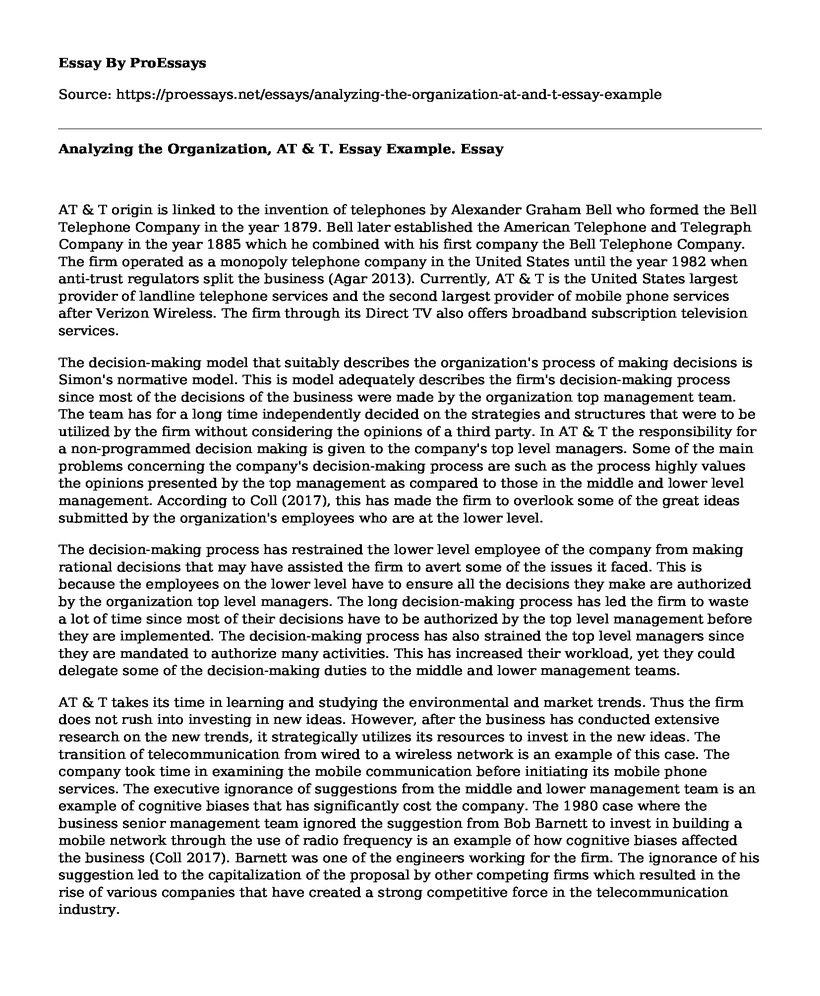AT & T origin is linked to the invention of telephones by Alexander Graham Bell who formed the Bell Telephone Company in the year 1879. Bell later established the American Telephone and Telegraph Company in the year 1885 which he combined with his first company the Bell Telephone Company. The firm operated as a monopoly telephone company in the United States until the year 1982 when anti-trust regulators split the business (Agar 2013). Currently, AT & T is the United States largest provider of landline telephone services and the second largest provider of mobile phone services after Verizon Wireless. The firm through its Direct TV also offers broadband subscription television services.
The decision-making model that suitably describes the organization's process of making decisions is Simon's normative model. This is model adequately describes the firm's decision-making process since most of the decisions of the business were made by the organization top management team. The team has for a long time independently decided on the strategies and structures that were to be utilized by the firm without considering the opinions of a third party. In AT & T the responsibility for a non-programmed decision making is given to the company's top level managers. Some of the main problems concerning the company's decision-making process are such as the process highly values the opinions presented by the top management as compared to those in the middle and lower level management. According to Coll (2017), this has made the firm to overlook some of the great ideas submitted by the organization's employees who are at the lower level.
The decision-making process has restrained the lower level employee of the company from making rational decisions that may have assisted the firm to avert some of the issues it faced. This is because the employees on the lower level have to ensure all the decisions they make are authorized by the organization top level managers. The long decision-making process has led the firm to waste a lot of time since most of their decisions have to be authorized by the top level management before they are implemented. The decision-making process has also strained the top level managers since they are mandated to authorize many activities. This has increased their workload, yet they could delegate some of the decision-making duties to the middle and lower management teams.
AT & T takes its time in learning and studying the environmental and market trends. Thus the firm does not rush into investing in new ideas. However, after the business has conducted extensive research on the new trends, it strategically utilizes its resources to invest in the new ideas. The transition of telecommunication from wired to a wireless network is an example of this case. The company took time in examining the mobile communication before initiating its mobile phone services. The executive ignorance of suggestions from the middle and lower management team is an example of cognitive biases that has significantly cost the company. The 1980 case where the business senior management team ignored the suggestion from Bob Barnett to invest in building a mobile network through the use of radio frequency is an example of how cognitive biases affected the business (Coll 2017). Barnett was one of the engineers working for the firm. The ignorance of his suggestion led to the capitalization of the proposal by other competing firms which resulted in the rise of various companies that have created a strong competitive force in the telecommunication industry.
Reference
Agar, J. (2013). Constant touch: A global history of the mobile phone. Icon Books Ltd.
Coll, S. (2017). The deal of the century: The breakup of AT&T. Open Road Media.
Cite this page
Analyzing the Organization, AT & T. Essay Example.. (2021, Jun 23). Retrieved from https://proessays.net/essays/analyzing-the-organization-at-and-t-essay-example
If you are the original author of this essay and no longer wish to have it published on the ProEssays website, please click below to request its removal:
- Paper Example on Financial Risk Management
- Regulation of Humanitarian Assistance Essay
- Essay Sample on Reinventing Business Strategies: Decentralized Manufacturing
- Confidential Agreement: Leadership Behaviors Stimulating Positivity - Dissertation Example
- Paper Example on Predictive Medicine: Computing Patient Risk & Appropriate Interventions
- Paper Example on Citizenfour: NSA Exceeding Power & Compromising Security of People
- Paper Sample on Ease Project Management with Clarizen: 4.6/5 Stars!







